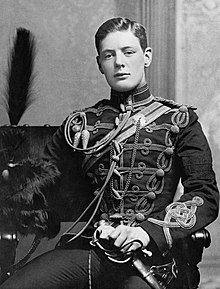Cornet (rank)


Cornet was originally the lowest grade of commissioned officer in a British cavalry troop, the modern equivalent being a second lieutenant. The rank was abolished by the 1871 Cardwell Reforms, which replaced it with sub-lieutenant. Although obsolete, the term is still used as an internal title of address when referring to a second lieutenant within the British Army regiments of the Blues and Royals and Queen's Royal Hussars.[2]
The cornet rank was also used by other nations such as the Imperial Russian Army and the Prussians.
Etymology[]
A cornet or "cornet of horse" was in the 17th and 18th century a term for a group of cavalry (typically 100–300 men), so-called because it was accompanied by a cornet player (a trumpet-like instrument, from Latin cornū, "horn").[3] Later "cornet" came to refer to the fifth commissioned officer in a cavalry troop, who carried the colours; it never referred to the cornet player himself.[4][5] An alternative etymology claims that the term is derived from a cornette, a woman's headdress, with a strip of lace hanging down from a headdress against the cheeks; later it referred to the pennon of a cavalry troop.[6][7]
History[]
The rank was in use by the time of the English Civil War. Among famous cornets in that conflict were George Joyce, Robert Stetson, and Ninian Beall.[8] It was abolished along with the purchase of commissions in the Army Reform Act of 1871, replaced by second lieutenant.
The ranks of ensign and cornet were abolished in the US Army in 1815.[9]
The rank also existed in other nations' cavalry troops, such as those of Denmark (kornet), Sweden (kornett) and Imperial Russia (корнет), and by the Continental Army in the American War of Independence. General Alexander Macomb was initially commissioned a cornet in a career in which he eventually became Commanding General of the United States Army.[10] It is still used in the artillery and cavalry divisions of the Netherlands (kornet).
The rank of field cornet (veldkornet) was used for the senior officer of a ward or sub-district in the independent republican states of the Transvaal and Oranje-Vrystaat in late 19th century South Africa. They were elected by the commandos of their ward for periods of three years. In the case of large wards, an assistant field cornet could also be chosen.[11] The rank was reminiscent of the Dutch use in cavalry troops that the commandos most closely resembled. In apartheid-era South Africa, the rank of field cornet was used in the South African Army from 1960[12] to 1968.[13]
Traditional duties[]
The subaltern rank of cornet was the equivalent of the contemporary infantry rank of ensign; today both have been supplanted by the rank of second lieutenant. The cornet carried the troop standard, known as a "guidon".[citation needed]
See also[]
References[]
- ^ "No. 26600". The London Gazette. 19 February 1895. p. 1001.
- ^ "The Armed Forces (Forms of Address)". Debretts. Retrieved March 2, 2018.
- ^ Bismark, Friedrich Wilhelm Graf von; Beamish, North Ludlow (November 12, 1855). "On the Uses and Application of Cavalry in War from the Text of Bismark: With Practical Examples Selected from Ancient and Modern History". T. & W. Boone – via Google Books.
- ^ O'Sullivan, Harold (1990). "Military Operations in County Louth in the Run-up to Cromwell's Storming of Drogheda". Journal of the County Louth Archaeological and Historical Society. 22 (2): 187–208. doi:10.2307/27729697. JSTOR 27729697 – via JSTOR.
- ^ "Definition of cornet | Dictionary.com". www.dictionary.com.
- ^ "Cornet | Definition of Cornet by Oxford Dictionary on Lexico.com also meaning of Cornet". Lexico Dictionaries | English.
- ^ Johnson, Samuel (November 12, 1818). "A Dictionary of the English Language: In which the Words are Deduced from Their Originals; and Illustrated in Their Different Significations, by Examples from the Best Writers: Together with a History of the Language, and an English Grammar". Longman, Hurst, Rees, Orme, and Brown – via Google Books.
- ^ Colonel Ninian Beall. (1937). Caleb Clarke Magruder. Records of the Columbia Historical Society. Vol. 37/38. pp. 17-29.
- ^ p.973 Tucker, Spencer C. The Encyclopedia of the Wars of the Early American Republic, 1783–1812: A Political, Social, and Military History [3 volumes]: A Political, Social, and Military History ABC-CLIO, 11 Jun 2014
- ^ Bell, William Gardner, Commanding Generals and Chiefs of Staff, 1775–2005: Portraits & Biographical Sketches of the United States Army's Senior Officer (Washington, D.C.: Center of Military History, U.S. Army, 2006). ISBN 0-16-072376-0.
- ^ "The Project Gutenberg e-Book of History of the War in South Africa, Vol. 1 of 4; Author: Sir Frederick Maurice". www.gutenberg.org.
- ^ "A dictionary of South African English on historical principles". Dictionary Unit for South African English - Rhodes University.
- ^ Duxbury, G. R. (June 1968). "Changes in Ranks and Designations in the South African Defence Force". Military History Journal. The South African Military History Society. 1 (2). ISSN 0026-4016.
- Military ranks of the British Army
- Household Cavalry